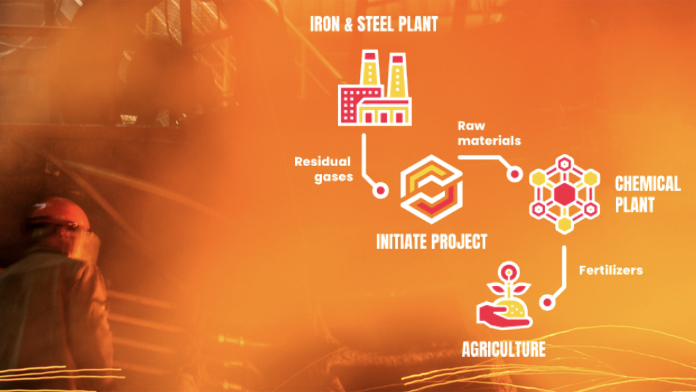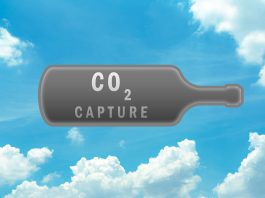Antonio La Mantia, Director of Communications and Events, and Anastasios Perimenis, Secretary General at CO2 Value Europe, explore the INITIATE project that uses carbon capture and utilisation to contribute to a climate-neutral and circular economy.
Scientists estimate that roughly 34 billion tonnes of carbon dioxide is emitted globally each year. This gives us a sense of the immense amount of CO2 emissions going into the atmosphere yearly without being seen or very well perceived by the public.
To grasp the scale of this phenomenon, imagine putting on magic glasses able to show you just a tonne of these CO2 emissions. We would then see a cube of about 8x8m (almost as tall, wide, and long as a utility pole) filled with carbon dioxide.
This enormous CO2 landfill floating above our heads is identified by the global scientific community as the primary driver of climate change. However, the good news is that what has been considered so far as a waste product can be captured and become a lower-cost feedstock for several industries.
Carbon capture and utilisation technology
Thanks to a broad portfolio of existing and developing carbon capture and utilisation (CCU) technologies, carbon dioxide can be captured and converted into a feedstock to create essential products. This is particularly true for the chemical sectors, including the production of chemicals, synthetic fuels and polymers, and at the same time for the energy sector, as it can provide useful storage solutions.
The most promising aspect of these technologies is not only that they can reduce CO2 emissions and avoid emissions but also that they can create a circular carbon economy able to de-fossilise our society, as captured CO2 is used by the industry as an alternative carbon feedstock to create different fuels and chemicals which are part of our daily life, via the so-called Power-to-X approach.
This approach sees the use of renewable electricity (Power), water and carbon dioxide as a feedstock to convert CO2 into products (X), like fuels, chemicals or commodity blocks. Against this context, first comes the source of CO2, which can be either an industrial point source like steel mills, incinerators, cement factories or the air via the so-called direct air capture. Then the approach, which can be electrochemical, thermochemical or biological, is able to form low and high-carbon molecules such as methanol, formic acid and ethylene, butanol and many others.
Captured CO2 can also be bound in mineral-rich industrial wastes (like ashes, slags, and construction wastes) to create solid materials (e.g. carbonates, bricks, and building materials). This process, known as mineralisation, is an industrially accelerated form of natural carbonation that already occurs in nature, though at a slow pace. Mineralising carbon does not only allow us to store carbon dioxide in products for hundreds of years, but it also allows us to create products that can substitute carbon-intensive products (e.g. cement).
This broad range of carbon capture and utilisation technology pathways are not emerging technologies anymore, as some of them are already at TRL 9 (commercialisation level), while others are in this wide spectrum range of TRLs starting from one to nine, so still in labs or prototype or pilot phase.
Challenges in commercialising CCU technologies
However, the route towards the scalability of CCU technologies is also faced with several challenges. First is the business case. As CCU solutions are often energy-intensive and require a significant initial investment for their implementation, they require significant investment in the CapEx and OpEx phases.
Secondly, there might be future unpredictable competition between fossil, biogenic and atmospheric CO2 to provide chemical feedstocks, material and fuel needs, and that shows the importance of assessing the future demand trends and potential penetration of these products via accurate marketing investigations. Third, as CCU has been envisioned as a ‘circular solution’, conflicting expectations and misconceptions may arise when it is mixed up with carbon capture and storage solutions (CCS), especially at the political level, given the different needs and challenges of these two different sectors. Fourth, when it comes to risk perception and public acceptance, it is now clear that the general public is not very well aware of CCU, and this may lead to relevant difficulties in assessing the acceptance in various areas of Europe. Last but not least, there are difficulties associated with assessing the impact of CCU technologies on the environment and the economy.
Tackling climate change with CCU
In 2022, the role of carbon capture and utilisation technology as a solution to mitigating climate change was recognised by the United Nations’ Intergovernmental Panel on Climate Change (IPCC).
In its sixth assessment report titled ‘Mitigation of Climate Change’, the UN panel not only identifies CCU technology as a solution to decrease net CO2 emissions but also stresses the importance of its critical role to end our reliance on fossil carbon by using CO2 as an alternative feedstock for the production of renewable fuels and chemicals.
In this context, the three major contributions of CCU technologies to mitigating climate change are:
- CCU technologies are drop-in solutions with limited new infrastructure needs and have the potential to utilise up to 8 Gt of CO2per year by 2050;1
- CCU allows to reduce or avoid CO2 emissions while maintaining essential services historically based on fossil resources; and
- CCU can provide CO2 removal solutions when atmospheric or biogenic CO2 is durably stored in products.
However, it is important to note once again that the impacts of these applications on the climate and also on the economy are contextual and dependent on various factors. The only fact that we are using CO2 to make a product does not automatically mean that the product is good for the planet or economically viable. As such, the role of carbon capture and utilisation technology in mitigating climate change should be determined through a comprehensive and systematic full life cycle assessment (LCA) to find the best possible ways for its scalability. At the same time, the economic factors influencing its commercialisation and deployment must be assessed via techno-economic assessment (TEA) to ensure the market will ultimately engage in this technology.
As stated by the IPCC, the different solutions to mitigate climate change should be based on sobriety, energy efficiency and circularity of goods, waste, and resources. The panel has also shown that industrial symbiosis and intersectoral co-operation are key to success.
INITIATE project
Against this context, the INITIATE project brings forward a concept of industrial symbiosis to contribute to the EU’s goal for a climate-neutral and circular economy. The concept is demonstrated by coupling energy-intensive industries like the iron and steel sector and the ammonia and urea sector.
Carbon capture and utilisation technology work to capture and transform residual gases like basic oxygen furnace gases (BOFG) from steelmaking into suitable feedstocks for urea production, namely NH3 and CO2 used as feedstock for the production of ammonia and urea.
This is a challenge beyond the state-of-the-art, following the variability and different properties of this new circular feedstock. Overall, the transformation is happening in sequence: the first step is the steel gases conditioning, comprising a water-gas-shift (WGS) reactor and a sorption-water-gas-shift (SEWGS) reactive-separation multi columns unit. In this section, residual steel gases are conditioned and separated into CO2 and H2/N2 streams. INITIATE optimises the intermediate H2/N2 product ratio to produce ammonia (NH3) and, via SEWGS, decarbonises this stream.
The resulting CO2 can be added to ammonia to produce urea, further used for the production of other carbon-containing molecules, or sent to geological sequestration. The NH3 synthesis loop is also designed for the flexible intake of green H2 from renewable energy electrolysis but does not rely on this for normal operation with Basic Oxygen Furnace Gas (BOFG) and Blast Furnace Gas (BFG).
INITIATE is an interdisciplinary project combining the disciplines of process modelling to model the dynamic elements of, among others, the NH3 synthesis loop and the SEWGS multi-column process concerning the varying feed-gas composition; catalysis and functional material characterisation to identify the appropriate sorbents and catalysts to deal with contaminants in the input; engineering and process control to design, construct and test both the individual components and the integrated value chain at demonstration and full implementation scale; LCA to assess the energy, economic and environmental advantages of the process over reference cases; business model development for a bankable design of a first-of-a-kind commercial plant to convert BOFG and BFG to NH3-based and carbon-containing products; and communication and stakeholder engagement to ensure synergies at local and European scale and replication of the concept for future successful deployment of this CCU technology.
The INITIATE project aims at a 30% decrease in primary energy use, a 40% decrease in raw material demand and an up to 90% reduction in direct CO2 emissions. Additionally, Europe is made more independent and robust, given the volatility of feedstock prices and trade uncertainties. Further benefits of this symbiotic concept are the provision of grid balancing services through flexibly using green H2 and by proving CO2 for circular use, accelerating the transition towards locally closed loop and integrated renewable energy systems.

The INITIATE project has received funding from the European Commission under the Horizon 2020 programme Ref: 958318.
References
- Hepburn, C. et al. (2019) The technological and economic prospects for CO2 utilization and removal. Nature, 575 (7781), pp. 87-97
Please note, this article will also appear in the fifteenth edition of our quarterly publication.









